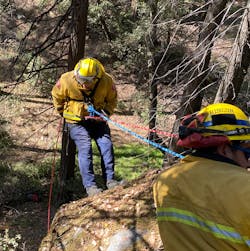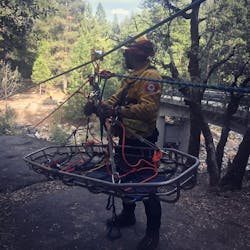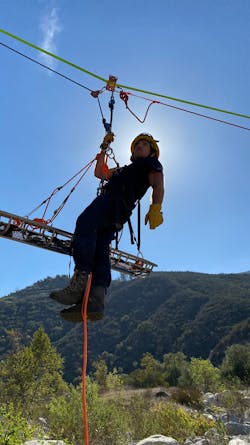Rapid Extrication for the Wildland Environment
At the end of the 2020 fire season, Rincon, CA, Fire Department (RFD) Fire Chief Ed Hadfield chose to engage in an area of wildland firefighting that previously was untapped by the RFD. With members already trained and certified as strike team leaders, safety officers, field observers, fireline EMTs and fireline paramedics, Hadfield decided to develop and form a stand-alone, fully equipped and staffed, highly trained rapid extrication module support (REMS) team. It would be a venture to an extent that has been unattained by any other San Diego County North Zone agency.
Hadfield knew that the best way to build an efficient, effective team required networking, acquiring the proper gear, and ensuring that the team was highly skilled and trained.
“The Rincon Fire Department has some of the most talented, hardworking and dedicated firefighters in the business,” Hadfield says. “In my 36 years of professional fire service, I have never worked with a more dedicated group of people whose work ethic is only surpassed by their passion to be the best. As fire chief, I’m thankful for the ongoing and unwavering support of the Council of the Rincon Band of Luiseno Indians, to which the RFD provides services, and the community at large. They all fully recognize how critical the REMS unit is to the life-safety of both firefighters and citizens during wildfire events.
“In addition, our REMS unit is fully funded by the Rincon Tribe at no cost to taxpayers of the county of San Diego.”
With REMS teams growing in usage and with a necessity in major wildland incidents as well as the fact that the Chula Vista, CA, Fire Department (CVFD) has the only other stand-alone REMS team in existence in San Diego County, the need for a REMS team was a clear necessity to Hadfield.
In the late fall of 2020, a committee was formed at the RFD and tasked with developing a REMS team. The committee’s directive was to collaborate with and research what other teams have in place and come up with a plan to make the RFD REMS team the best possible.
Optional equipment
The RFD REMS committee networked with teams at the CVFD, the Long Beach, CA, Fire Department, the Fresno, CA, Fire Department, and the Reno, NV, Fire Department, among others. The REMS committee discussed training standards, transport apparatus, equipment utilized and other elements. Speaking with these teams and utilizing their knowledge and experience was incredibly beneficial. It allowed the committee to really focus on the lessons that the other departments learned and to put together the best product possible.
One of the main discussion points was optional equipment. Although the FIRESCOPE program requires a standard equipment list, there are ways to augment the list. For example, the Arizona Vortex artificial high-directional (AHD) system has been found to be invaluable when in need of a highpoint during operations. As well, given that the REMS team consists of four members, the portable winch provides valuable lifting/hoisting capabilities. With the help of all of these teams and several others, the REMS committee began working on plans for Rincon’s team.
In total, the list that RFD’s REMS committee put together was broken down to: equipment that’s used for road-based rescues and; lightweight compact gear that can be hiked in for rescues that are deep into the wildland arena.The RFD’s REMS road-based complement includes multiple CMC multipurpose devices (MPDs), harnesses, a titanium stokes basket with an all-terrain wheel, and Rock-N-Rescue pickets and picket plates.
The hiking complement is technical rescue-rated, including materials that are used by professional climbers, such as Petzl’s RollClip pulley-carabiner and Tibloc ultralight emergency ascender; CMC 3/8-inch rope; and aluminum hardware that streamlines building mechanical advantage with minimal equipment.
The government of the Rincon Band of Luiseno Indians fully supported and funded the purchase of a Ford F-350, an enclosed trailer and a Polaris Ranger UTV, to assist with access to remote areas.
Training
With the equipment and apparatus taken care of, the focus then was directed to training the team.
Beginning in the spring of 2021, all RFD members were certified in wildland firefighting, completing courses in wildland fire behavior, mapping and compass work, and Wildland Firefighter I.
Although not a requirement of the FIRESCOPE program, the department also certified most of its members as line EMTs or paramedics.
One challenge that the department faced was scheduling REMS-specific training during fire season while navigating schedules of on-duty and off-duty members and of department members who were deployed on fire assignments. However, as an example of their dedication to the success of the REMS team, all members found a way to overcome scheduling obstacles to ensure participation in all required training.With the focus being on the development of rope rescue, all members attended low-angle rope rescue operations (LARRO) training. REMS team members continued their training by completing Rescue Systems 1 (RS1) and Rope Rescue Technician (RRT). All REMS team members also were required to attend additional in-house training prior to being eligible for deployment as well as to continue with quarterly training.
Once on deployment, the REMS team participates in daily training.
Daily training on deployments in 2021 began by dedicating a significant amount of time per day to specific training to ensure safe, efficient and cohesive teamwork. One model that was utilized while training while out on deployment incorporated the team scouting out the work division and anticipating worst-case scenarios that are based on the work that was being performed by the groups that are in the area.
Each day the team rotated the team lead, and a member identified a potential rescue area. From that point, members assumed roles, were given direction from the team lead and effected a simulated rescue.
Another element of training while on deployment: repetitions to develop and enhance proficiency. As with so many things in the profession, lack of frequency has the potential to lessen performance. Understanding that time is of the essence on a REMS rescue, the team sets aside time daily for members to practice basic techniques, which include rigging, tying knots, passing knots and setting up mechanical advantage systems in an efficient manner utilizing a variety of equipment. All of this additional training and practice also is beneficial in the department’s local area.
Being in such a rural area in northern San Diego County, there are ample training areas to practice for a variety of wildland scenarios. Although not built into local dispatch, the REMS unit can be an effective resource for responding to local emergencies in the rural environment. The RFD recently was approached by a neighboring department regarding planning responses in a very steep and rugged recreational area. Working in partnership, the REMS team is developing on plans for providing services and developing response plans for the area. All elements of the REMS unit, including the hiking cache, the road-based rescue and the UTV, are applicable and warranted for the area.
Wildland and other incidents
As wildfires grow in size each year, so does the complexity of the resources that are ordered. With federal agencies already utilizing REMS teams judiciously and state agency use growing in popularity in wildland incidents, the RFD REMS team plans to assist in the wildland arena whenever it’s called on by outside agencies.
The team will continue to work, train and collaborate with other agencies to ensure that the best product is sent out to do the most good in the wildland arena as well as at local incidents at home.
About the Author
Sammy Listoe
Sammy Listoe is a firefighter EMT and has been with the Rincon Fire Department in Valley Center, CA, for two and a half years. He was voted Firefighter of the Year in 2020. Listoe manages the department's small engines equipment and social media accounts and assists in its rope rescue program.
Larry Hogueisson
Larry Hogueisson is an engineer paramedic and has been with the Rincon Fire Department in Valley Center, CA, for four years. He is the department's rope rescue specialist and was a driving force in putting together its rapid extrication module support (REMS) team.


